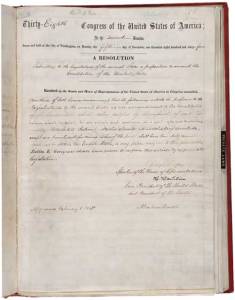Daily Archives: 02/01/2024
1790 – The U.S. Supreme Court convened for the first time in New York City.
1960 – Lunch counter Protests for Service and Equality by Students
1960 – In Greensboro, North Carolina, four African American students sat down and ordered coffee at a lunch counter inside a Woolworth’s store. They were refused service, but did not leave. Instead, they waited all day. The scene was repeated over the next few days, with protests spreading to other southern states, resulting in the eventual arrest of over 1,600 persons for participating in sit-ins.
Emancipation Proclamation: The 13th Amendment ~ Feb. 1, 1865
February 1, 1865
National Archives social media intern Anna Fitzpatrick.

Joint Resolution Proposing the Thirteenth Amendment to the United States Constitution, 01/31/1865–01/31/1865; Enrolled Acts and Resolutions of Congress, 1789–2008; General Records of the United States Government, 1778–2006, Record Group 11; National Archives (National Archives Identifier: 1408764)
The news of the Emancipation Proclamation was greeted with joy, even though it did not free all the slaves. Because of the limitations of the proclamation, and because it depended on a Union military victory, President Lincoln recognized that the Emancipation Proclamation would have to be followed by a constitutional amendment in order to abolish slavery.
After the Senate passed a bill for an amendment in April 1864, but the House of Representatives did not, Lincoln suggested that the bill be taken up by the Republican Party in its 1864 platform for the upcoming Presidential elections.
His efforts met with success when the House passed the bill in January 1865. On February 1, 1865, President Abraham Lincoln approved the Joint Resolution of Congress submitting the proposed amendment to the state legislatures. The necessary number of states ratified it by December 6, 1865.
The 13th Amendment to the United States Constitution formally abolished slavery in the United States. It provides that ”Neither slavery nor involuntary servitude, except as a punishment for crime whereof the party shall have been duly convicted, shall exist within the United States, or any place subject to their jurisdiction.”
The struggle for complete freedom was far from finished even with the 13th Amendment. Two more amendments were added to the Constitution. Ratified in 1868, the 14th Amendment increased the liberties and rights granted by the Bill of Rights to former slaves. Two years later the 15th Amendment was ratified, giving African American men the right to vote. The Emancipation Proclamation helped make these rights and liberties available for newly freed people, as it was one of the first steps towards freedom for former slaves.
The 13th Amendment and its history are featured in the online exhibit “Our Documents.”
The story of the creation of the 13th Amendment is featured in “The Meaning and Making of Emancipation,” a free eBook created by the National Archives. You can read it on your iPad, iPhone, Nook, or other electronic device.
Pieces of History
January 3, 2013 by hilary parkinson, posted in – Civil War, Presidents
A blog of the U.S. National Archives
******************************
Passed by Congress on January 31, 1865, and ratified on December 6, 1865, the 13th amendment abolished slavery in the United States.
The 13th amendment, which formally abolished slavery in the United States, passed the Senate on April 8, 1864, and the House on January 31, 1865. On February 1, 1865, President Abraham Lincoln approved the Joint Resolution of Congress submitting the proposed amendment to the state legislatures. The necessary number of states ratified it by December 6, 1865. The 13th amendment to the United States Constitution provides that “Neither slavery nor involuntary servitude, except as a punishment for crime whereof the party shall have been duly convicted, shall exist within the United States, or any place subject to their jurisdiction.”
In 1863 President Lincoln had issued the Emancipation Proclamation declaring “all persons held as slaves within any State, or designated part of a State, the people whereof shall then be in rebellion against the United States, shall be then, thenceforward, and forever free.” Nonetheless, the Emancipation Proclamation did not end slavery in the nation. Lincoln recognized that the Emancipation Proclamation would have to be followed by a constitutional amendment in order to guarantee the abolishment of slavery.
The 13th amendment was passed at the end of the Civil War before the Southern states had been restored to the Union and should have easily passed the Congress. Although the Senate passed it in April 1864, the House did not. At that point, Lincoln took an active role to ensure passage through congress. He insisted that passage of the 13th amendment be added to the Republican Party platform for the upcoming Presidential elections. His efforts met with success when the House passed the bill in January 1865 with a vote of 119–56.
With the adoption of the 13th amendment, the United States found a final constitutional solution to the issue of slavery. The 13th amendment, along with the 14th and 15th, is one of the trio of Civil War amendments that greatly expanded the civil rights of Americans.
ourdocuments.gov


You must be logged in to post a comment.